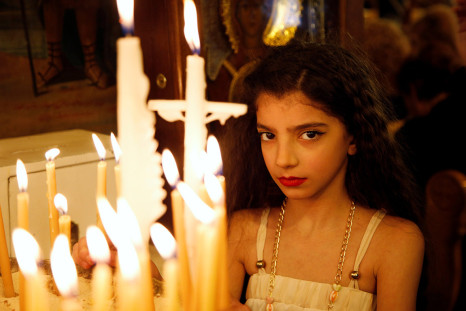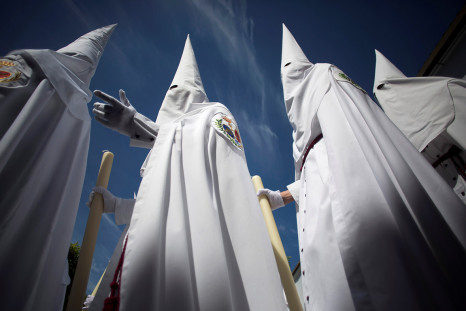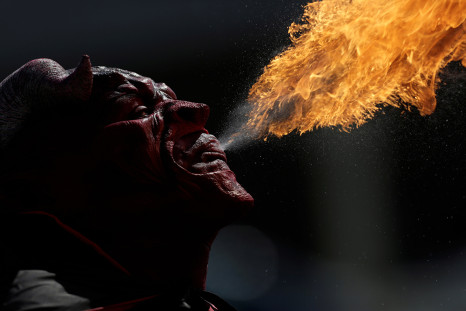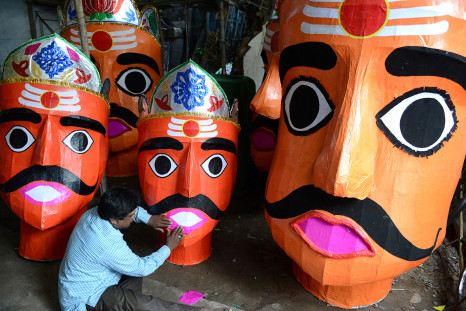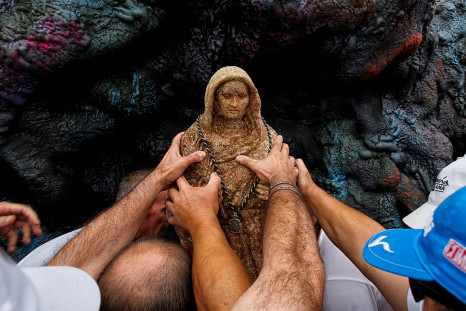Home
> Religion Picture Galleries
Religion Picture Galleries
Palm Sunday 2017: Christians around the world mark the start of Holy Week
Palm Sunday commemorates the day Christians believe Jesus entered Jerusalem and was welcomed as the messiah only to be crucified five days later.
Alex Wheeler Apr 10, 2017
Images of Holy Week 2017 in Spain: Hooded penitents parade through streets
Hundreds of processions featuring hooded figures are held around the clock during Holy Week in cities and towns all over Spain.
David Sim Apr 10, 2017
Rebel female Buddhist monks shave their heads as they continue to battle for religious rights
Getty Images photographer Roberto Schmidt photographed Thai women as they approach their ordination at a temple in Bangkok.
Alex Wheeler Apr 06, 2017
Tomb-Sweeping Day in pictures: Chinese people give fake money, food and wine to ancestors during Qingming Festival
People burn incense, fake money and paper models of houses, cars and other goods in the belief their ancestors will be able to enjoy them in the afterlife.
David Sim Apr 04, 2017
Police raid Wat Dhammakaya Buddhist temple to search for monk wanted for money laundering
It was not clear if the former abbot, 72-year-old Phra Dhammachayo, was inside Thailand's biggest Buddhist temple.
David Sim Feb 16, 2017
Venice carnival: Masked revellers take part in the Carnevale di Venezia in Italy's floating city
The carnival madness first began in the 11th century as a period of excess before the rigours of Lent, the 40 days of fasting that traditionally precede Easter.
Alex Wheeler Feb 13, 2017
Hindu devotees across Nepal celebrate Swasthani Bratakatha festival
Festival begins on first full moon day in the Nepali Poush month and ends on the next full moon day a month later.
Alex Wheeler Feb 10, 2017
Hindu devotees pierce their bodies with metal rods for Thaipusam Festival
Thaipsuam is a celebration dedicated to the HIndu god of war, Lord Murugan, and is held over a two-day period.
Alex Wheeler Feb 09, 2017
In pictures: Devotees worship Iemanja, the Afro-Brazilian queen of the sea
Often depicted as a mermaid, she is said to be able to cure infertility in women.
David Sim Feb 03, 2017
Epiphany: Orthodox Christians plunge into ice holes cut into frozen rivers and lakes
Orthodox Christians across eastern Europe have braved some of the lowest temperatures in decades as they plunged into icy water to celebrate the Epiphany.
David Sim Jan 19, 2017
Manila brought to a standstill as millions of Catholics flock to see 'miraculous' black Jesus Christ statue
The icon, referred to as The Black Nazarene, is thought to have healing powers.
Alex Wheeler Jan 09, 2017
Thousands of candles illuminate Pashupatinath temple to remember dead at Bala Chaturdashi festival
The temple is considered to be the most sacred of Lord Shiva and sees Hindus from across Nepal and India travel to the Nepalese capital for the annual event.
Alex Wheeler Nov 28, 2016
Arbaeen: Millions of Shia Muslims gather in Karbala in world's largest annual pilgrimage
Arbaeen commemorates the end of a 40-day mourning period after the killing of Imam Hussein, the Prophet Muhammad's grandson, during a battle in 680 AD.
David Sim Nov 21, 2016
Chhath puja: Hindu devotees immerse themselves in water to pay homage to sun god Surya
Sun worship is believed to help cure a variety of diseases and helps ensure the longevity and prosperity of loved ones.
Alex Wheeler Nov 07, 2016
Day of the Dead: Millions of people across the world pay their respects to the deceased
Cities such as Mexico City, Lima and La Paz spend the early days of November paying tribute to those who have died.
Alex Wheeler Nov 02, 2016
Onward Christian soldiers! First mass held at church recaptured from Isis
Church bells rang out for the first time in two years in the town on the outskirts of Mosul.
David Sim Oct 31, 2016
Photo gallery: Colourful Diwali 2016 celebrations around the world
The Hindu festival of lights symbolises taking people from darkness to light in the victory of good over evil.
David Sim Oct 31, 2016
Beautiful photos of Sukkot celebrations throughout the years
Sukkot has both historical and agricultural origins and will be observed from 16- 23 October 2016.
Alex Wheeler Oct 18, 2016
Yom Kippur: Photos of rituals carried out ahead of the Day of Atonement
Some Orthodox Jews wave a live chicken over their heads, believing they will be purged of their sins.
David Sim Oct 11, 2016
Dussehra 2016 photos: Hindu festival celebrating triumph of good over evil
Dussehra commemorates a battle in which Lord Rama defeated the 10-headed demon king Ravana in order to save his wife Sita.
David Sim Oct 11, 2016
Ashura 2016: Shia Muslims flagellate themselves with chains and knives [graphic images]
Shia Muslims are gathering for Ashura, which commemorates the death of the Prophet Muhammad's grandson Imam Hussein at the battle of Karbala.
David Sim Oct 10, 2016
Devotees pierce their faces with bicycles, rifles and recorders during gruesome vegetarian festival
Those taking part, show their religious devotion through ritualistic and self-mutilating trials.
Alex Wheeler Oct 03, 2016
Stunning photos of Nigeria's Durbar festival, marking Eid al-Adha
Crowds turn out after many stayed away from the Muslim festival last year due to a Boko Haram attack that killed 35.
David Sim Sep 21, 2016
Beautiful photos of China's Uighur Muslims celebrating the Corban Festival, or Eid al-Adha
Award-winning photojournalist Kevin Frayer visits a remote village in far western China during the 'feast of the sacrifice'.
David Sim Sep 16, 2016
Iranian pilgrims banned from Hajj amid rising tensions with Saudi Arabia
At least one million Iranians have travelled to Iraq to observed Arafat Day in the holy Shia city of Karbala.
Alex Wheeler Sep 12, 2016
Photos of the Hajj, one of the world's largest pilgrimages
The hajj draws the faithful to the holy city of Mecca and areas around it for five intense days of rituals and prayers.
David Sim Sep 12, 2016
Hajj 2016: Saudi Arabia tightens security ahead of holy pilgrimage
Efforts are being made to strengthen crowd management following last years stampede, where over 2,000 people died.
Alex Wheeler Sep 07, 2016
Aerial photographs show Mecca's breathtaking sights ahead of Hajj 2016
Around 3.7 million people make the Hajj pilgrimage each year.
Alex Wheeler Sep 06, 2016
Sea of death: World's biggest cemetery filling up as Iraq's battle against Isis takes its toll
The Wadi al-Salam cemetery in Najaf covers about 10 square kilometres and contains five million bodies.
David Sim Aug 23, 2016
Underwater Virgin Mary statue retrieved from ocean for day of worship
The statue rests 15 metres below sea level, and requires scuba divers to find it.
Alex Wheeler Aug 17, 2016
Pages
- PREV
- 1
- 2
- 3
- 4
- NEXT


